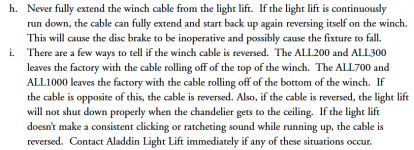BendLikeaGirl
Member
- Location
- Chicago
- Occupation
- Licensed Electrician
I have a customer who has a Wilshire lift. Apparently when lowered the lift cable will not remain taut when raised. I personally do not work on these lift mechanisms and with Wilshire having been discontinued since 2002, I can't find any literature in the way of any sort of manual or troubleshooting guide. Does anyone happen to have access to this manual or have any idea of who could work on something like this in the Chicago area? I don't want to replace the chandelier until this is remedied in case it has something to do with disc brake failure or the winding mechanism.


